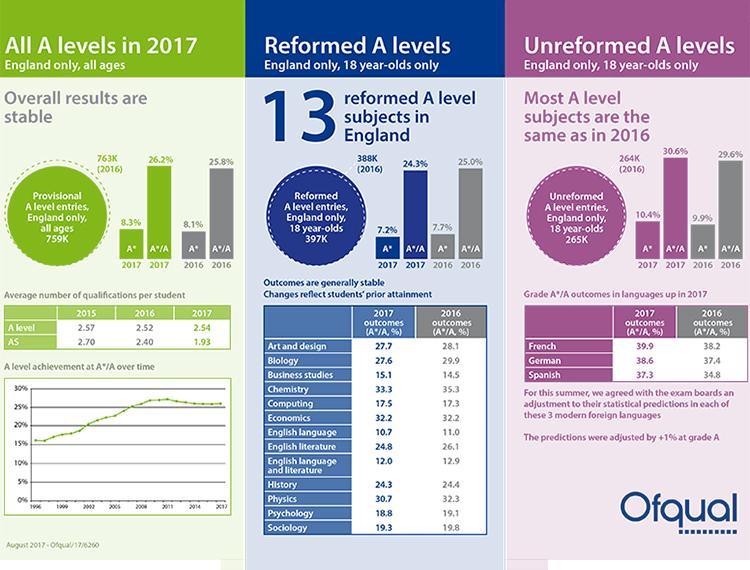Guide to AS and A level results for England, 2017

Ofqual’s guide to results, standards and grade boundaries in the 2017 AS and A level results.
Key points
- Overall results are stable for reformed and unreformed A levels. It is important not to over-interpret relatively small changes in year-on-year results.
- Entries for reformed AS have dropped which makes it much more difficult to compare year-on-year results.
- In A level French, German and Spanish, outcomes at grades A* and A are up following an agreement with exam boards to make an adjustment to take account of native speakers in these languages.
Today (17 August 2017) Ofqual are publishing:
- a summary of this year’s results (below)
- an infographic about this year’s A level results
- a report on variability in AS and A level results for schools, 2015 to 2017
- interactive analytics of variability in school and college AS and A level results
You may also find it useful to read about how they regulate GCSEs, AS and A levels in England.
An historical perspective: the past 20 years
The principle of comparable outcomes is not new. It has always been used by exam boards, particularly when qualifications change. It’s a principle that exam boards have followed for decades: that if the ability of the cohort of students is similar to previous years, they would expect results (outcomes) to be similar.
The phrase ‘comparable outcomes’ has also come to mean awarding based on statistical predictions, because that’s the way Ofqual and the exam boards put that principle into practice. Predictions give us a way to maintain standards, in addition to senior examiner judgements. And crucially, they give a mechanism to make sure exam boards’ standards are aligned, so that it is no easier to get a grade with one than with another. Since Ofqual started to set tolerances around those predictions (in 2010 for A level), results in recent years have been stable year-on-year (see graph below).

Setting standards in A levels in 2017
The approach outlined above has been used for all A levels this year – reformed and unreformed (the only difference is that in reformed specifications, there were no tolerances because exam boards agreed to get outcomes as close as possible to predictions). It is particularly important at times of change, to protect students from being disadvantaged because they are the first to sit new qualifications. Ofqual have been clear since before students embarked on these new courses that they and the exam boards would use predictions to maintain standards in these new A levels.
In the 2017 A level awards, exam boards used predictions based on students’ prior attainment at GCSE. And, as in previous years, senior examiners have been involved in all awards. In the reformed A levels this year they were asked to check whether student work at the grade boundaries suggested by the statistics was acceptable for the grade (either A or E). Ofqual have not intervened to ask any boards to change their grade boundaries this summer.
Results in reformed A level subjects
Ofqual have not changed the standards in the new A levels. They are the same standard as the previous A levels. The small decrease in outcomes for 18-year-old students this year reflects the fact that those taking these subjects in 2017 have slightly lower prior attainment than the students in summer 2016.
The following table shows the predicted A* and A outcomes for 18-year-old students in summer 2016 compared to summer 2017 (the predicted outcomes are based on data supplied by the exam boards during July 2016 and July 2017). Predicted outcomes are based on the relationship between prior attainment (GCSE for A level predictions) and national results in that subject in a reference year, and are used by awarding bodies to guide their awarding decisions. If the prior attainment of the cohort increases relative to the reference series, then the predicted outcomes will also increase. Conversely, if the prior attainment of the cohort decreases then the predicted outcomes will also decrease.
The following table shows that in all but two subjects (art & design, and computing), the predicted outcomes at grade A and above were lower in summer 2017 when compared to summer 2016. This shows that the prior attainment of the 18-year-old students sitting these subjects in summer 2017 was lower than in summer 2016 (for reformed A levels, 2016 data includes England, Wales and Northern Ireland students; 2017 data is England only). This has been reflected in a decrease in outcomes for 18-year-old students in summer 2017.
| Subject | 2016 predicted outcomes at A* and A % | 2017 predicted outcomes at A* and A % | Change (2017 – 2016) % |
|---|---|---|---|
| Art & design | 27.88 | 27.89 | 0.01 |
| Biology | 28.91 | 26.75 | -2.16 |
| Business studies | 15.45 | 14.47 | -0.98 |
| Chemistry | 34.54 | 32.52 | -2.02 |
| Computing | 16.58 | 17.76 | 1.18 |
| Economics | 31.43 | 29.86 | -1.57 |
| English language | 10.57 | 9.93 | -0.64 |
| English literature | 25.31 | 24.07 | -1.24 |
| English language & literature | 12.70 | 11.82 | -0.88 |
| History | 23.51 | 23.15 | -0.36 |
| Physics | 31.11 | 29.22 | -1.89 |
| Psychology | 18.63 | 17.87 | -0.76 |
| Sociology | 19.43 | 18.75 | -0.68 |
Number of qualifications per student
JCQ data present numbers of entries and certifications, rather than data at student level. This is because students typically take AS and A levels with more than one exam board. (It is also worth noting that many students also take AS or A levels alongside other qualifications, which Ofqual have not included in this analysis.) Ofqual have combined the exam board data to look at the average number of AS or A levels per student. This is shown in the table below. For A level, the average number has remained stable, whereas for AS the average number of qualifications per student has dropped. This is not surprising, given the drop in entries for reformed AS in 2016 and 2017.
Average number of qualifications per student
| Overall | 2015 | 2016 | 2017 |
|---|---|---|---|
| A level | 2.57 | 2.52 | 2.54 |
| AS level | 2.70 | 2.40 | 1.93 |
Grade boundaries
It is difficult to compare in a meaningful way grade boundaries between old and new qualifications, for several reasons. Maximum marks for the papers differ, the number of papers in a subject differs, and the type of assessment can be different. Where some of the old qualifications had coursework, grade boundaries on written papers may have been higher to compensate for high performance on the coursework.
Comparing the previous unitised A levels and the linear A levels is also challenging because the new qualifications no longer use UMS marks. All of these differences mean that looking at individual subjects is unhelpful, but combining grade boundaries across a number of subjects can highlight trends.
The graph below shows the grade boundaries, for examined units or paper only, as a percentage of the maximum mark, in the reformed A level subjects. This shows that, in general, the percentage of marks that students have to score to achieve a grade A has remained very similar. At E, the percentage of marks that students have to score has dropped. This may reflect differences in the type of assessment. As part of the awarding process, senior examiners reviewed student work at all the A and E boundaries and were content that it reflected an appropriate level of performance for that grade.

A level French, German and Spanish
The findings from the native speaker research show that native and non-native speakers perform differently, with native speakers out-performing the non-native speakers in each language. Native speakers also outperform their statistical prediction based on prior attainment at grade A. However, the relatively small numbers of native speakers means that the effect on the overall outcomes is relatively small.
As a result of our research, for this summer Ofqual agreed with exam boards an adjustment to the grade A statistical predictions that are used to guide the setting of grade boundaries in each of the three languages. The same adjustment, +1% at grade A, was applied in each of the three languages.
| Language | Grade | 2016 | 2017 |
|---|---|---|---|
| French | A* | 8.7 | 10.5 |
| French | A | 37.6 | 39.4 |
| German | A* | 9.4 | 9.9 |
| German | A | 39.8 | 41.2 |
| Spanish | A* | 8.4 | 10.4 |
| Spanish | A | 34.6 | 37.2 |
A level science endorsement
Practical science work is reported separately in the reformed A level biology, chemistry and physics qualifications. Students have to complete at least twelve different experiments over the two years of their course, which are assessed according to criteria that are common to all exam boards. A separate pass grade is issued to those students who meet the criteria for a pass.
The table below shows the percentage of students achieving a pass in the practical skills endorsement, broken down by their A level grade (these figures are based on data supplied to Ofqual by the exam boards on or before 15th August – whilst the data is not complete, any missing data is likely to be missing at random). It is not surprising that most students have achieved this endorsement given the period over which the practicals are completed. Students achieving higher A level grades are slightly more likely to achieve a pass in the practical endorsement.
| Grade | Not classified % | Pass % | Total entry |
|---|---|---|---|
| A* | 0.09 | 99.91 | 10860 |
| A | 0.08 | 99.92 | 25724 |
| B | 0.18 | 99.82 | 27551 |
| C | 0.61 | 99.39 | 25670 |
| D | 1.19 | 98.81 | 20446 |
| E | 2.72 | 97.28 | 10901 |
| U | 8.53 | 91.47 | 4324 |
| Total | 0.91 | 99.09 | 125476 |











Responses